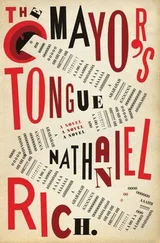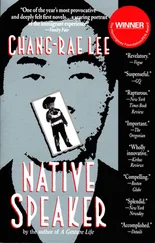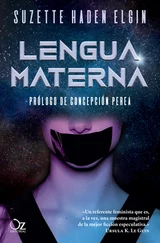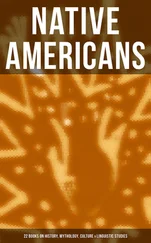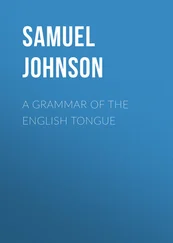At the same time, the novel serves us well as historical record of the dystopian visions central to a particular stage of feminism, for the life of linguist women mirrors in its stringencies the harshest social critiques of second stage feminism: patriarchal domination, sex as an instrument of control, women subject to the whims of their male masters and categorized solely by their sexual and reproductive capacities. Yet Native Tongue reflects the partial vision of its era, too, particularly in its insistence on seeing men and women as unified groups necessarily opposed to one another in thought, action, and desire. Contemporary readers may well wish for another project that would encode a newer language, one that complicates the idea of a “native tongue” by challenging its basis in a fixed and gendered identity.
While Elgin’s novelistic vision of the future was dystopic, the strategies of language she and her characters employed provide new avenues of critique and change. Just as the novel both reveals language to be based on gendered assumptions and provides new ways to think about both language and reality, we can explore the ways language helps encode other power hierarchies, including those of race, class, sexual orientation, and even the human over other species. In doing so, we can employ new linguistic strategies to challenge these power structures and encode a reality more equitable for all.
Susan Squier
Julie Vedder
Pennsylvania State University
June 2000
Bothamley, Jennifer. Dictionary of Theories . London, Detroit: Gale Research International, 1993.
Cohen, Debra Rae. Rev. of Native Tongue. Voice Literary Supplement October 1984: 18.
De Lauretis, Teresa. Technologies of Gender: Essays on Theory, Film and Fiction . Bloomington: Indiana University Press, 1987.
Elgin, Suzette Haden. “A Feminist Is a What?” Women and Language 18.2 (1995): 46.
———. The Gentle Art of Verbal Self Defense . 1980. New York: Barnes and Noble, 1985.
———. “Laadan, the Constructed Language in Native Tongue. ” Suzette Haden Elgin’s Website (www.sfwa.org/members/elgin/Laadan.html) Online. March 2000.
———. The Language Imperative . Cambridge, MA: Perseus Books, 2000.
———. “Linguistics and Science Fiction.” Suzette Haden Elgin’s Website (www.sfwa.org/members/elgin/SHE_info.html) Online. March 2000.
———. “Washing Utopian Dishes; Scrubbing Utopian Floors.” Women and Language 17.1 (1994): 43–47.
———. “Women’s Language and Near Future Science Fiction: A Reply.” Women’s Studies 14 (1987): 175–181.
Heilbrun, Carolyn. Rev. of Native Tongue and Native Tongue II: The Judas Rose. Women’s Review of Books July–August 1987: 17.
Hofstadter, Douglas R. Goedel, Escher, Bach: An Eternal Golden Braid . New York: Vintage Books, 1979.
Irigaray, Luce. This Sex Which Is Not One . Trans. Catherine Porter. Ithaca, New York: Cornell University Press, 1985.
Martin, Emily. “The Egg and the Sperm: How Science Has Constructed a Romance Based on Stereotypical Male-Female Roles.” Signs: Journal of Women in Culture and Society 16.3 (1991): 1–18.
Rev. of Native Tongue. Booklist November 1984: 342.
Rev. of Native Tongue. Publishers Weekly 225 (1984): 98.
Pinker, Steven. The Language Instinct . New York: HarperCollins, 1994.
Rosinsky, Natalie. Feminist Futures: Contemporary Women’s Speculative Fiction . Ann Arbor: UMI Reseach Press, 1984.
Sellers, Susan, ed. The Hélèn Cixous Reader . New York: Routledge, 1994.
Shelley, Mary. Frankenstein, Or, A Modern Prometheus . 1831. New York: Signet Classics, 1965.
Squier, Susan. “From Omega to Mr. Adam: The Importance of Literature for Feminist Science Studies.” Science, Technology, & Human Values 24.1 (1999): 132–158.
Taormina, Agatha. “Womanspeak.” Fantasy Review November 1984: 31.
Elgin’s nonfictions series has grown quite extensive. In addition to the original Gentle Art of Verbal Self-Defense , it includes The Last Word on the Gentle Art of Verbal Self-Defense (1987), The Gentle Art of Written Self-Defense: Letters in Response to Triple-F Situations (1993), Genderspeak: Men, Women, and the Gentle Art of Verbal Self-Defense (1993), and The Gentle Art of Communicating With Kids (1996), among others.
While linguists have, for the most part, discarded this theory in favor of the school of thought pioneered by Noam Chomsky — which contends that the capacity for language is wired into our brains by evolution, rather than developed as a result of our environment — the idea survives in many other disciplines. All the same, there is some confusion about the actual meaning of the Sapir-Whorf hypothesis. The “strong” version, which Elgin claims no one has ever advocated, says that our language determines our perception of reality ( Language Imperative 52). It is this version that is often discredited. The “weak” version, to which Elgin subscribes, also known as the linguistic relativity hypothesis, says only that our language structures and constrains our perception of reality. For a discussion of all these competing theories, see Steven Pinker, The Language Instinct , especially pages 55–82.
Gödel’s theorem argues that within any fixed system, there are truths that exist, but are not provable within the system (Hofstadter 101). In other words, no system is complete, and in any attempt to include new things, the system necessarily changes. In the case of Native Tongue , the fixed system is a masculine, violent, hierarchical culture and language. Elgin’s experiment was to see what would happen if she tried to “prove” the truth of a women’s language. For a detailed discussion of Gödel’s theorem, see Douglas Hofstadter, Gödel, Escher, Bach .
This theme appears in Earthsong: Native Tongue III , which has as its central character a linguist woman who communicates with the spirit of one of the oldest old who has just died — a linguist woman who helped to create Láadan.


